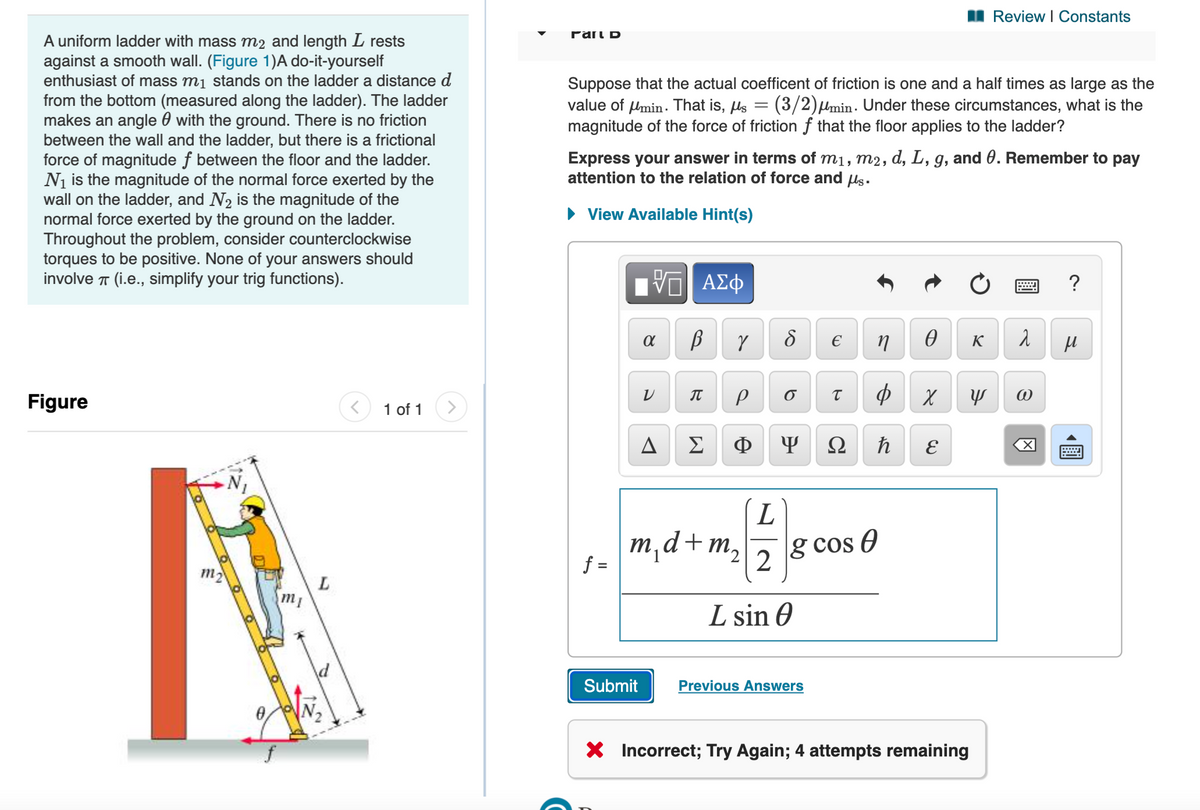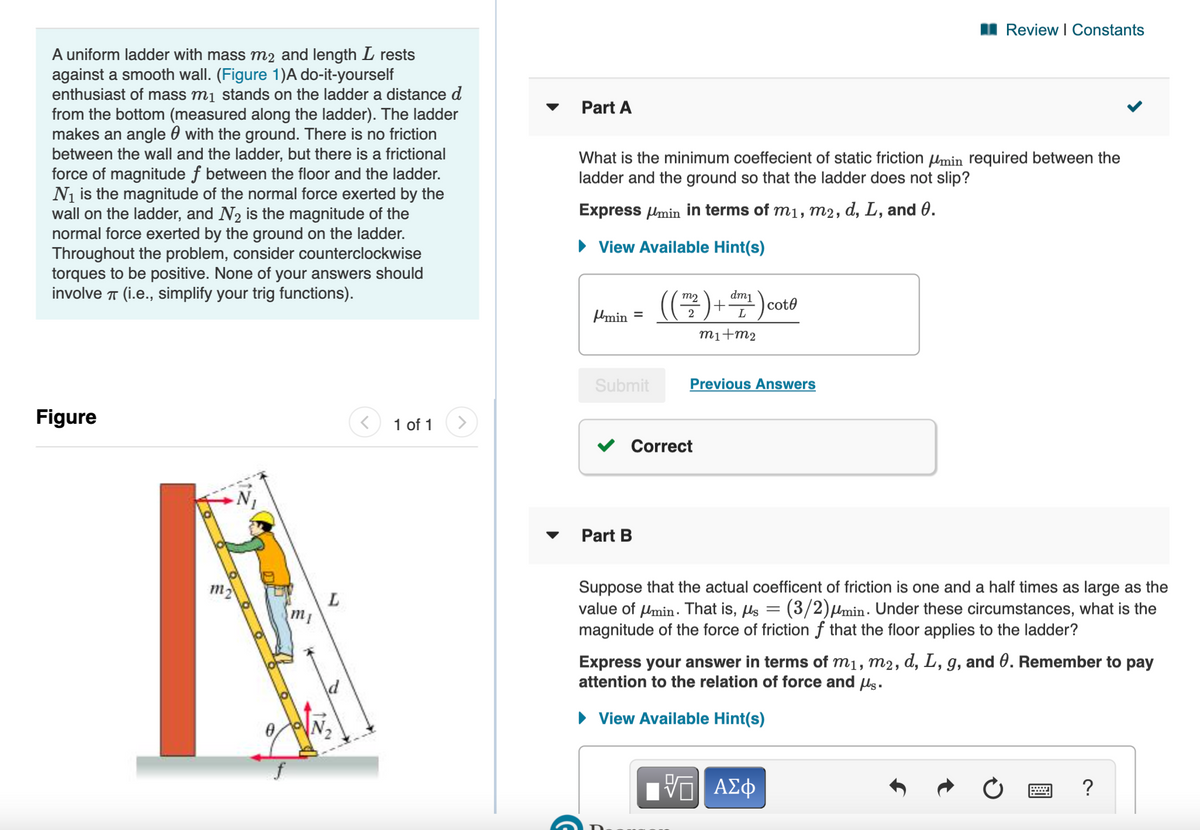I Review I Constants A uniform ladder with mass m2 and length L rests against a smooth wall. (Figure 1)A do-it-yourself enthusiast of mass mị stands on the ladder a distance d from the bottom (measured along the ladder). The ladder makes an angle 0 with the ground. There is no friction between the wall and the ladder, but there is a frictional force of magnitude f between the floor and the ladder. Nj is the magnitude of the normal force exerted by the wall on the ladder, and N2 is the magnitude of the normal force exerted by the ground on the ladder. Throughout the problem, consider counterclockwise torques to be positive. None of your answers should involve T (i.e., simplify your trig functions). Farl D Suppose that the actual coefficent of friction is one and a half times as large as the value of Pmin - That is, ls = (3/2)µmin . Under these circumstances, what is the magnitude of the force of friction ƒ that the floor applies to the ladder? Express your answer in terms of m1, m2, d, L, g, and 0. Remember to pay attention to the relation of force and ls. • View Available Hint(s) ? € K Figure 1 of 1 Σ Ф Ω m,d+m, cos O 2 f = m L sin 0 Submit Previous Answers X Incorrect; Try Again; 4 attempts remaining
I Review I Constants A uniform ladder with mass m2 and length L rests against a smooth wall. (Figure 1)A do-it-yourself enthusiast of mass mị stands on the ladder a distance d from the bottom (measured along the ladder). The ladder makes an angle 0 with the ground. There is no friction between the wall and the ladder, but there is a frictional force of magnitude f between the floor and the ladder. Nj is the magnitude of the normal force exerted by the wall on the ladder, and N2 is the magnitude of the normal force exerted by the ground on the ladder. Throughout the problem, consider counterclockwise torques to be positive. None of your answers should involve T (i.e., simplify your trig functions). Farl D Suppose that the actual coefficent of friction is one and a half times as large as the value of Pmin - That is, ls = (3/2)µmin . Under these circumstances, what is the magnitude of the force of friction ƒ that the floor applies to the ladder? Express your answer in terms of m1, m2, d, L, g, and 0. Remember to pay attention to the relation of force and ls. • View Available Hint(s) ? € K Figure 1 of 1 Σ Ф Ω m,d+m, cos O 2 f = m L sin 0 Submit Previous Answers X Incorrect; Try Again; 4 attempts remaining
Principles of Physics: A Calculus-Based Text
5th Edition
ISBN:9781133104261
Author:Raymond A. Serway, John W. Jewett
Publisher:Raymond A. Serway, John W. Jewett
Chapter10: Rotational Motion
Section: Chapter Questions
Problem 74P: A stepladder of negligible weight is constructed as shown in Figure P10.73, with AC = BC = ℓ. A...
Related questions
Concept explainers
Rotational Equilibrium And Rotational Dynamics
In physics, the state of balance between the forces and the dynamics of motion is called the equilibrium state. The balance between various forces acting on a system in a rotational motion is called rotational equilibrium or rotational dynamics.
Equilibrium of Forces
The tension created on one body during push or pull is known as force.
Question

Transcribed Image Text:II Review I Constants
ran D
A uniform ladder with mass m2 and length L rests
against a smooth wall. (Figure 1)A do-it-yourself
enthusiast of mass mị stands on the ladder a distance d
from the bottom (measured along the ladder). The ladder
makes an angle 0 with the ground. There is no friction
between the wall and the ladder, but there is a frictional
force of magnitude f between the floor and the ladder.
Ni is the magnitude of the normal force exerted by the
wall on the ladder, and N2 is the magnitude of the
normal force exerted by the ground on the ladder.
Throughout the problem, consider counterclockwise
torques to be positive. None of your answers should
involve T (i.e., simplify your trig functions).
Suppose that the actual coefficent of friction is one and a half times as large as the
value of Umin . That is, Hs = (3/2)µmin . Under these circumstances, what is the
magnitude of the force of friction f that the floor applies to the ladder?
Express your answer in terms of m1, m2, d, L, g, and 0. Remember to pay
attention to the relation of force and us.
• View Available Hint(s)
?
K
IT
Figure
1 of 1
Σ
Ф
Ω
E
L
m,d+
f =
g cos O
2
m2
L sin O
Submit
Previous Answers
N2
X Incorrect; Try Again; 4 attempts remaining

Transcribed Image Text:I Review l Constants
A uniform ladder with mass m2 and length L rests
against a smooth wall. (Figure 1)A do-it-yourself
enthusiast of mass mį stands on the ladder a distance d
from the bottom (measured along the ladder). The ladder
makes an angle 0 with the ground. There is no friction
between the wall and the ladder, but there is a frictional
force of magnitude f between the floor and the ladder.
Ni is the magnitude of the normal force exerted by the
wall on the ladder, and N2 is the magnitude of the
normal force exerted by the ground on the ladder.
Throughout the problem, consider counterclockwise
torques to be positive. None of your answers should
involve T (i.e., simplify your trig functions).
Part A
What is the minimum coeffecient of static friction Umin required between the
ladder and the ground so that the ladder does not slip?
Express lmin in terms of m1, m2, d, L, and 0.
• View Available Hint(s)
(-)
dm1
+
L
m2
cote
Mmin
2
%3D
mi+m2
Submit
Previous Answers
Figure
1 of 1
V Correct
Part B
Suppose that the actual coefficent of friction is one and a half times as large as the
value of Umin. That is, ls = (3/2)µmin . Under these circumstances, what is the
magnitude of the force of friction f that the floor applies to the ladder?
m2
m1
Express your answer in terms of m1, m2, d, L, g, and 0. Remember to pay
attention to the relation of force and us.
• View Available Hint(s)
N2
?
Expert Solution
This question has been solved!
Explore an expertly crafted, step-by-step solution for a thorough understanding of key concepts.
This is a popular solution!
Trending now
This is a popular solution!
Step by step
Solved in 2 steps with 2 images

Knowledge Booster
Learn more about
Need a deep-dive on the concept behind this application? Look no further. Learn more about this topic, physics and related others by exploring similar questions and additional content below.Recommended textbooks for you

Principles of Physics: A Calculus-Based Text
Physics
ISBN:
9781133104261
Author:
Raymond A. Serway, John W. Jewett
Publisher:
Cengage Learning

University Physics Volume 1
Physics
ISBN:
9781938168277
Author:
William Moebs, Samuel J. Ling, Jeff Sanny
Publisher:
OpenStax - Rice University

Principles of Physics: A Calculus-Based Text
Physics
ISBN:
9781133104261
Author:
Raymond A. Serway, John W. Jewett
Publisher:
Cengage Learning

University Physics Volume 1
Physics
ISBN:
9781938168277
Author:
William Moebs, Samuel J. Ling, Jeff Sanny
Publisher:
OpenStax - Rice University